Hassani S. Mathematical Physics: A Modern Introduction to Its Foundations
Подождите немного. Документ загружается.


(20.1)
20 _
Green's Functions in One Dimension
Our treatment of differential equations, with the exception of SOLDEs with con-
stant coefficients, did not consider inhomogeneous equations.
At
this point, how-
ever, we
can
put into use one
of
the most elegant pieces
of
machinery in higher
mathematics, Green's functions, to solve inhomogeneous differential equations.
This chapter addresses Green's functions in one dimension, that is, Green's
functions of ordinary differential equations. Consider the ODE
Lx[u] =
f(x)
where Lxis a lineardifferential operator. In the abstract Dirac notation this can be
formally written as
L lu) =
If}.
If
L has an inverse
L-
1
sa G, the solution can be
formally written as
lu) =L
-I
If}
=G
If}.
Multiplying thisby (xl and inserting
1
= f dy Iy)
w(y)
(yl between G and
If)
gives
u(x)
= f
dyG(x,
y)w(y)f(y),
where the integrationis over the range of definitionof the functions involved. Once
we know
G(x,
y),
Equation (20.1) gives the solution
u(x)
in an integral form.
But
how do we find
G(x,
y)?
Sandwiching both sides of LG = 1 between (xl and Iy) and using 1 =
f
dx'lx'}
w(x')
(x'i between L and G yields f
dx'L(x,
x')w(x')G(x',
y) =
(xl
y) = 8(x -
y)jw(x)
if
we use Equation (6.3). In particular,
if
L is a local
differential operator (see Section 16.1), then
L(x,
x')
= [8(x -
x')jw(x)]L
x,
and
differential
equation
we obtain
for
Green's
function
(
8(x -
y)
LxG(x,
y) = --'C....,-7"'-
w(x)
or
LxG(x,
y) = 8(x -
y),
(20.2)
where the second equation makes the frequently used assumption that
w(x)
= 1.
Green's
function
G(x,
y) is calledthe
Green's
function
(GF) for the differential operator(DO) Lx.

554 20.
GREEN'S
FUNCTIONS
IN
ONE
OIMENSION
As discussed iu Chapters 16 and 18, Lx might uot be defined for all functions
on R Moreover, a complete specification of
Lx
reqnires some initial (or boundary)
conditions. Therefore, we expect
G(x,
y) to depend on such initial conditions as
well. We note that when
Lx
is applied to (20.1), we get
Lxu(x)
= f
dy[Lx(G(x,
y)]w(y)f(y)
= f
dy
8(x
- y)
w(y)f(y)
=
f(x),
w(x)
indicating that
u(x)
is indeed a solution
of
the original ODE. Equation (20.2),
involving the generalized function
8(x
- y) (or disttibution in the language
of
Chapter 6), is meaningful only in the same context. Thus, we treat
G(x,
y) not as
an ordinary function but as a
distribution. Finally, (20.1) is assumed to holdfor an
arbitrary (well-behaved) function
f.
20.1 Calculation of Some Green's Functions
This section presents some examples
of
calculating
G(x,
y) for very simple DOs.
Laterwe will see how to obtainGreen'sfunctions for a generalsecond-orderlinear
differential operator. Although the complete specification
of
GFs requires bound-
ary conditions, we shall introduce unspecified constants in some of the examples
below, and calculate some
indefinite GFs.
20.1.1.
Example.
Let us findthe GF forthe simplestDO,
Lx
=
d/dx.
Weneedto find
a
distribution
such
that
its
derivative
is the
Dirac
delta
function:
1
G'
(x, y) =
cS
(x - y).
In
Chapter
6, we
encountered
sucha distribution-the step
function
B(x -
y).
Thus,
G(x,
y) = O(x - y) +
aryl,
where
aryl
isthe "constant"ofintegration.
III
The example above did not include a boundary (or initial) condition. Let us
see how boundary conditions affect the resulting GF.
20.1.2.
Example.
Letussolve
u'(x)
=
f(x)
wherex E [0,00) andu(O) =
O.
Ageneral
solution of thisDEis givenby
Equation
(20.1) andthe
preceding
example:
u(x)
=
fooo
O(x -
y)f(y)dy
+
foOO
a(y)f(y)dy.
Thefactor8(x - y) inthe firsttermonthe RHSchopsofftheintegralatx:
u(x)
= fox
f(y)dy
+
fooo
a(y)f(y)dy.
TheBegives0 = u(O)=
0+
Jo
oo
a(y)f(y)dy.
Theonlywaythatthiscanbesatisfied for
arbitrary
fey)
is for
aryl
to be zero.Thus,
G(x,
y) = O(x - y), and
u(x)
=
foOO
O(x -
y)f(y)dy
= fox
f(y)dy.
1Hereandelsewhere in this
chapter,
aprimeoveraGF
indicates
differentiation
withrespectto its
first
argument.
(
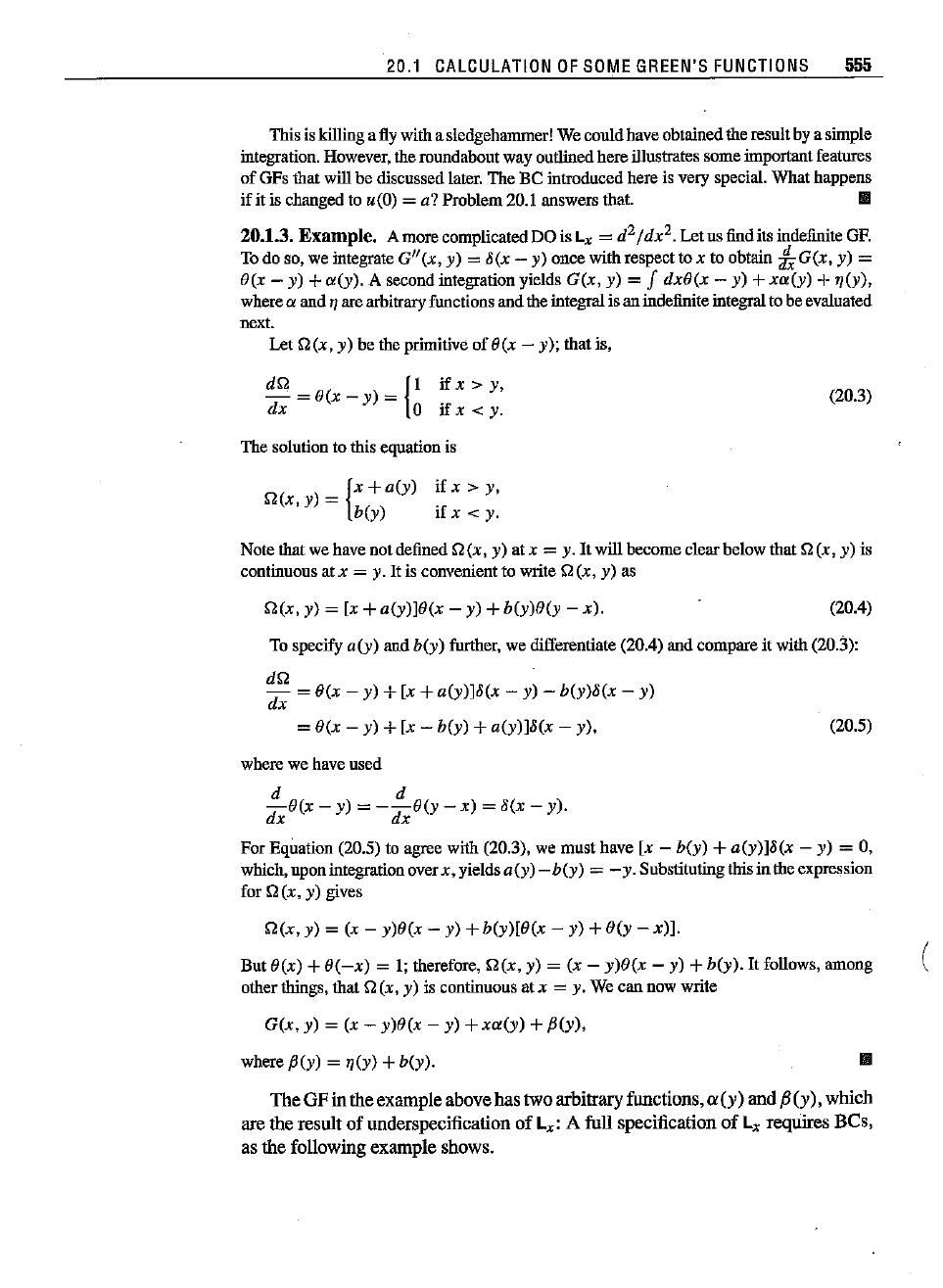
20.1
CALCULATION
OF
SOME
GREEN'S
FUNCTIONS
555
Thisiskillingaflywitha
sledgehammer!
Wecouldhave
obtained
the
result
byasimple
integration.
However,
the
roundabout
way
outlined
here
illustrates
some
important
features
of GFs
that
will bediscussed
later.
The
Be
introduced
hereis very
special.
What
happens
if it is changed to u(O) = a? Problem 20.1 answers lbat.
III
20.1.3. Example. A more complicated DO is Lx = d
2
/
dx
2.
Let us find its indefinite GF.
Todo so, we integrate GI/(x, y) =8(x - y) ouce wilbrespect to x to obtain
-!xG(x,
y) =
O(x - y) +
a(y).
A secoud integration yields
G(x,
y) = f dxO(x - y) +
xa(y)
+
~(y),
where
a
and
11
are
arbitrary
functions
andthe
integral
isan
indefinite
integral
tobe
evaluated
next.
Let
Q(x,
y) be the primitive of O(x - y); lbat is,
dQ"(
{I
if x > y,
- =u
x-y)
=
dx 0 if x < y.
Thesolution tothis
equation
is
Q(x,
y) =
{x
+a(y)
if x > y,
bey)
if x < y.
(20.3)
Note
that we have not defined
Q(x,
y)
atx
= y. It will become c1earbelow lbat
Q(x,
y) is
continuous at x = y. Itis convenient to writeQ (x, y) as
Q(x,
y) = [x
+a(y)]e(x
- y)
+b(y)e(y
-x).
(20.4)
To specify
aryl
and bey) further, we differentiate (20.4) and compare it wilb (20.3):
dQ
dx = O(x - y) +[x +
a(y)]8(x
- y) -
b(y)8(x
- y)
=O(x - y) +[x - bey) +
a(y)]8(x
- y), (20.5)
where we have used
d d
dx
O(x - y) =- dx O(y - x) =8(x - y).
For Equation (20.5) to agree wilb (20.3), we must bave [x - bey) +
a(y)]8(x
- y) = 0,
which,upon
integration
overx, yields
a(y)
-
b(y)
=
-y.
Substituting
thisintheexpression
for
Q(x,
y) gives
Q(x,
y) = (x -
y)e(x
- y) +b(y)[O(x - y) +O(y -
x)].
But O(x) +
Or-x)
= I; therefore,
Q(x,
y) = (x -
y)e(x
- y) +bey). It follows, among
other
things,
that
n (x, y) is
continuous
atx = y. Wecannowwrite
(
G(x,
y) = (x -
y)e(x
- y) +
xa(y)
+fJ(y),
where fJ(y) =
~(y)
+bey).
III
The
GF
in
the
example
above
has
two
arbitrary
functions,
Ol
(y)
and
fJ
(y),
which
are
the
result
of
underspecification
of
Lx: A
full
specification
of
Lx
requires
Bes,
as
the
following
example
shows.
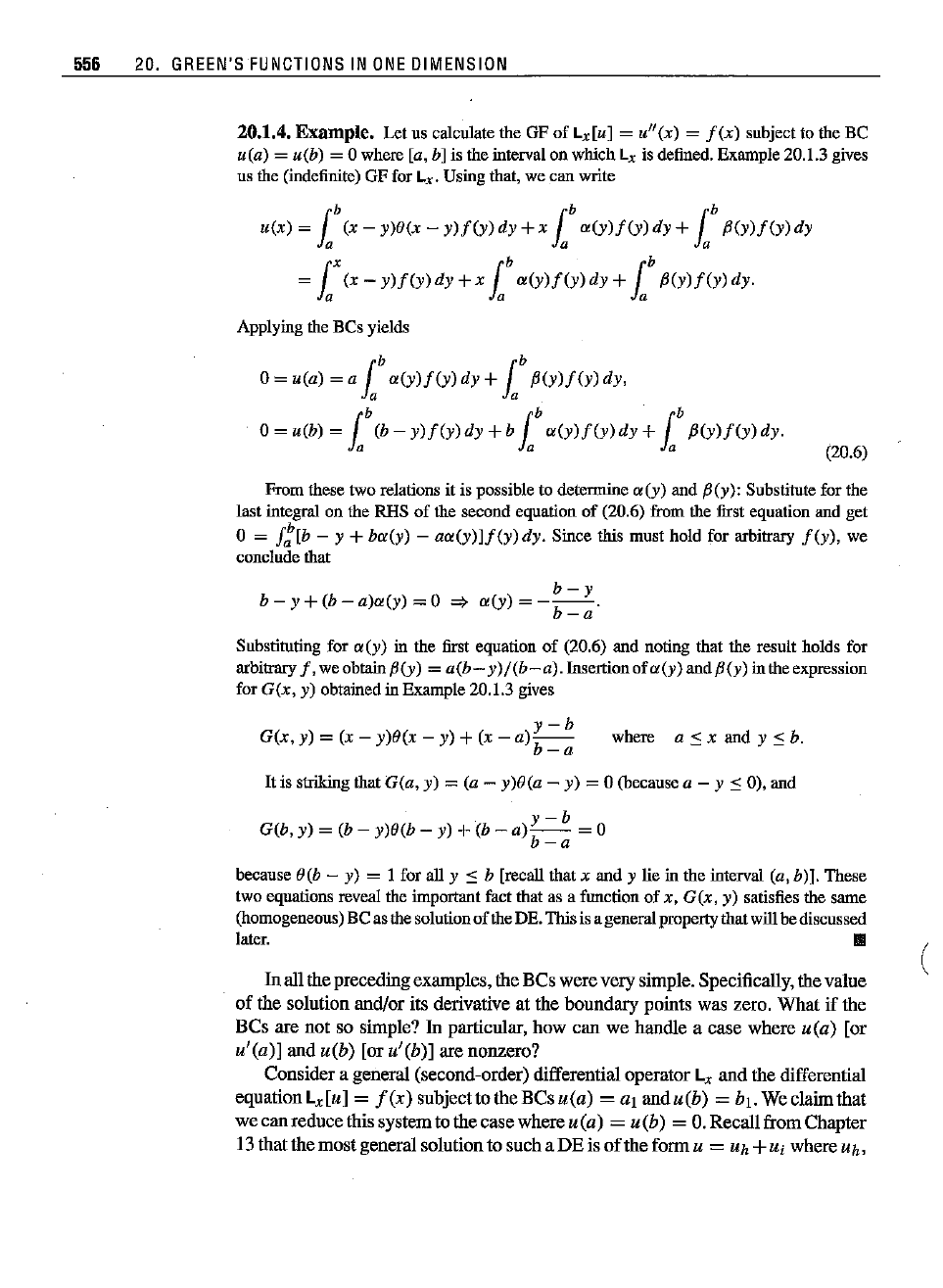
556 20.
GREEN'S
FUNCTIONS
IN
ONE
OIMENSION
20.1.4.
Example.
Let us calculate the GF of Lx[u] =
u"(x)
=
f(x)
subjectto the BC
u(a) = u(b) = 0 where [a, b] is theiutervalon which
Lx
is defined.Example20.1.3gives
us the(indefinite) GFfor Lx.Using that,we canwrite
u(x)
= l
b
(x -
y)e(x
-
y)f(y)
dy
+x l
b
a(y)f(y)
dy
+l
b
fJ(y)f(y)
dy
=
LX
(x -
y)f(y)
dy
+x l
b
a(y)f(y)
dy
+l
b
fJ(y)f(y)
dy.
Applyiugthe BCs yields
0=
u(a) = a l
b
a(y)f(y)
dy
+l
b
fJ(y)f(y)
dy,
0=
u(b) = l
b
(b -
y)f(y)
dy
+b l
b
a(y)f(y)
dy
+t
fJ(y)f(y)
dy.
(20.6)
where
a:::;
x and y
::s:
b.
From
thesetwo
relations
it is possibleto determine
ex
(y) and
fJ
(y):
Substitute
forthe
last iutegral on the RHS of the second equation of (20.6) from the first equation and get
o= J/;[b - y +
ba(y)
-
aa(y)]f(y)
dy.
Siuce this must hold for arbitrary
fey),
we
concludethat
b-y
b - y +(b -
a)a(y)
=0
=>
a(y)
=
---.
b-a
Substituting for a (y) iu the first equation of (20.6) and noting that the result holds for
arbitrary
f,
weobtainfJ(y) =
a(b-y)/(b-a).
Insertionofa(y)
andfJ(y) iutheexpression
for
G(x,
y) obtaiuediu Example20.1.3 gives
y-b
G(x,
y) =(x -
y)e(x
- y) +(x - a) b _ a
It
is strikingthat
G(a,
y) =(a -
y)e(a
- y) =0 (becausea - y
~
0), and
y-b
G(b,
y) = (b -
y)e(b
- y) +(b - a) b _ a = 0
because
e(b
- y) = 1 for all y
~
b [recallthat x and y lie iu the iuterval (a, b)J. These
two
equations
revealthe
important
factthatas a functionof x,
G(x,
y) satisfiesthe same
(homogeneous)
Be
asthesolution
of
the DE.Thisisageneral
property
that
willbediscussed
later.
III
In all the precedingexamples,the BCs wereverysimple, Specifically, the value
of
the solution and/or its derivative at the boundary points was zero.
What
if
the
BCs are not so simple?
In particular,
how
can
we handle a case where
u(a)
[or
u'(a)]
and
u(b)
[or
u'(b)]
are nonzero?
Consider a general (second-order) differential operator Lx
and
the differential
equationLx[u]
=
J(x)
subjecttotheBCsu(a) = at andu(b) =
bl.
We claimthat
we
can
reducethis systemto
the
casewhere u(a) = u(b) =
O.RecallfromChapter
13 that
the
most
general solutionto such a
DE
is
of
the
form u = Uk +u, where
Uk,
(

20.2
FORMAL
CONSIDERATIONS
557
the solution to the homogeneous equation, satisfies Lx
[Uh]
= 0 and contains the
arbitrary parameters inherent in solutions
of
differential equations.
For
instance,
if
the linearly independent solutions are v and w,then Uh(X) = C,
v(x)
+
C2W(X)
and Ui is any solution of the inhomogeneous DE.
If
we demand that uh(a) =
a,
and uh(b) =b, then u, satisfies the system
Lx[uil
=
f(x),
Uj(a)
=
ui(b)
=0,
which is
of
the type discussedin the preceding examples. Since Lxis a SOLDO, we
can put all the machinery of Chapter13to workto obtain
v
(x),
w
(x),
and therefore
Uh(X). The problem then reduces to a DE for which the BCs are homogeneous;
that is, the value
of
the solution and/orits derivative is zero at the boundary points.
20.1.5.Example. Let us asswne that Lx = d
2/dx
2
Calculation of Uhis trivial:
d2uh
Lx[Uh]
= 0
~
-2-
= 0
~
Uh(X) =
c'x
+C2·
dx
Toevaluate C, and C2, we impose the BCs Uh(a) =
a,
and uh(b) =
b,:
C,a
+C2 =
at.
C,b
+C2 =
b,.
This gives C, = (b, -
a,)/(b
- a) and C2 =
(a,b
-
ab,)/(b
- a).
The
inhomogeneous
equation
defines
a
problem
identical
to
that
of
Example
20.1.4.
Thus, we can immediately write Ui(X) =
I:
G(x,
y)f(y)
dy, where
G(x,
y) is as given in
thatexample.Thus,thegeneralsolutionis
hI - at
alb
-
abl
l
x
x -
alb
u(x)
=
~x
+ b _ a + a (x -
y)f(y)
dy +b _ a a (y -
b)f(y)
dylll
Example 20.1.5 shows that an inhomogeneous DE with inhomogeneous BCs
can be separated into two DEs, one homogeneous with inhomogeneous BCs and
the other inhomogeneous with homogeneous BCs, the latterbeing appropriate for
the OF.Futthermore, all the foregoing examplesindicate that solutions of DEs can
be succinctly written in terms
of
OFs that automatically incorporate the BCs as
long as the BCs are homogeneous. Can a
OF
also give the solution to a DE with
inhomogeneons BCs?
20.2 FormalConsiderations
The discussion and examples
of
the preceding sectionhintat the power of Green's
functions. The elegance of such a function becomes apparentfrom the realization
that it contains all the information about the solutions of a DE for any type of BCs,
as we are about to show. Since OFs are inverses
of
DOs,
let
us briefly reexamine
the inverse
of
an operator, which is closely tied to its specttum. The question as
(

558
20.
GREEN'S
FUNCTIONS
IN
ONE
OIMENSION
to whether or not an operator Ain a finite-dimensional vector space is invertible
is succinctly answeredby the value of its determinant:
A is invertibleif and only
if
detA
t=
O.
In fact, as we saw at the beginning of Chapter 16, one translates the
abstractoperator equation
A lu) = [u) into a matrix equation Au = v and reduces
the question to that of the inverseof a matrix. This matrix takes on an especially
simpleformwhen
Aisdiagonal,thatis,when Aij = Ai
Bij.
Forthisspecialsituation
we have
for
i =
1,2,
...
, N
(no sum over i).
(20.7)
This equation has a nnique solution (for arbitrary Vi) if and only if Ai
t=
0 for all
i, In that case Ui =
Vi/Ai
for i =
1,2,
...
,
N.
In particnlar, if Vi = 0 for all i,
that is, when Equation (20.7) is homogeneous, the unique solution is the trivial
solution.
Ontheotherhand,when someof the Ai arezero,theremaybe no solution
to
(20.7), but the homogeneousequationhas a nontrivial solution (Ui need not be
zero). Recalling (fromChapter
3) that an operator is invertible
if
and only if none
of its eigenvaluesis zero, we havethe following:
20.2.1.Proposition.
The
operator A E
J:.,
(V) isinvertible ifandonlyifthe
homo-
geneous
equation
A
Iu)
= 0 hasnonontrivial
solutions.
In infinite-dimensional(Hilbert) spaces there is no determinant. How can we
tell whether or not an operator in a Hilbert space is invertible? The exploitation
of the connection between invertibility and eigenvalues has led to Proposition
20.2.1, whichcan be generalizedto an operator acting on any vector space,finite
or infinite. Consider the equation
A lu) = 0 in a Hilbert space
1(.
In general,
neither the domain nor the range of
A is the whole of
1(.
If
A is invertible, then
the only solutionto the equation
A lu) = 0 is lu} =
O.
Conversely, assuming that
the equationhas no nontrivialsolution implies that the null space of
A consists of
only the zero vector.Thus,
Thisshowsthat
Aisinjective(one-to-one),i.e.,A is abijectivelinearmappingfrom
the domain of
A, 1J(A), onto the range of A. Therefore, A must have an inverse.
The foregoing discussion can be expressed as follows.
If
Alu) = 0, then (by
the definitionof eigenvectors)
A = 0 is an eigenvalueof A if and only
if
lu)
t=
o.
Thus,
if
A Iu) = 0 has no nontrivial solution,then zero cannotbe aneigenvalueof (
A. This can alsobe stated as follows:
20.2.2. Theorem.
An operator Aona Hilbertspacehasan
inverse
ifandonlyif
A= 0 isnotan
eigenvalue
ofA.
Green's functionsareinversesof differentialoperators.Therefore,it is impor-
tantto have a clearunderstanding of the DOs.
An nth-order linear differentialop-
erator(NOLDO)satisfiesthefollowingtheorem(foraproof,see [Birk 78,Chapter
6]).
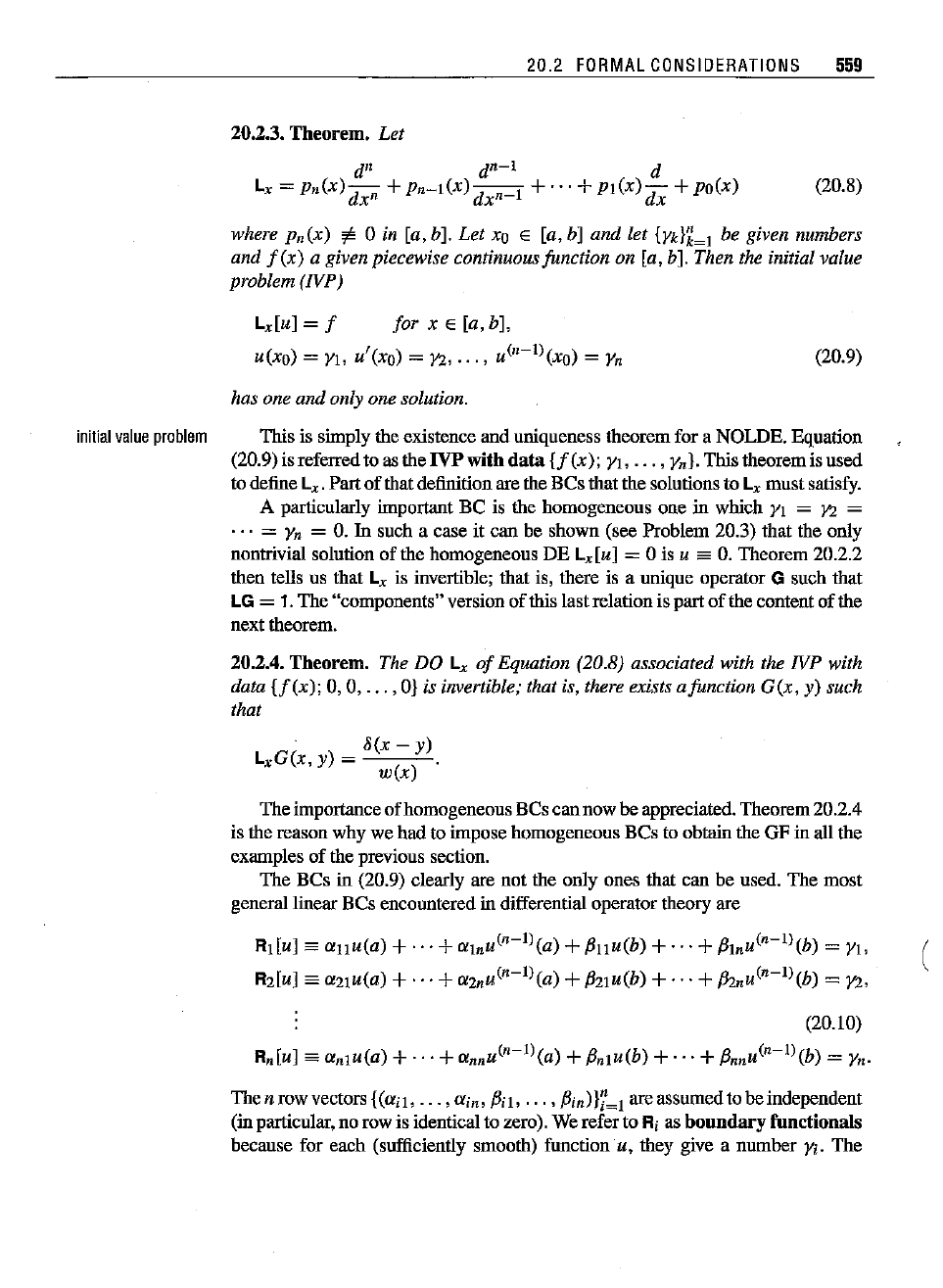
20.2
FORMAL
CONSIOERATIONS
559
20.2.3.
Theorem.
Let
d" d
n-
I
d
Lx
=
P,,(x)-d
+
Pn-I(X)-d
1+'"
+ PI
(x)-d
+
po(x)
x
n
x":
X
(20.8)
(20.9)
where p,,(x) ¢ 0 in [a, b].
Let
Xo
E [a, b]
and
let
{YklZ~1
be given numbers
and
f(x)
a given piecewise continuous function on [a, b]. Then the initial value
problem
(IVP)
Lx[u] = f
for
x E [a, b],
u(xo)
= YI, u'(xo) =
J!2,
...
, uC,,-I\xO) = Yn
has one and only one solution.
initial
value
problem
This is simply the existence and uniqueness theorem for a NOLDE. Equation
(20.9) is referredto as the
IVPwith
data
(f(x);
YI,
...
,
YnJ.
This Iheoremisused
to define
Lx.
Part
of
Ihatdefinition are the BCs Ihat the solutions to
Lx
must satisfy.
A particularly important BC is the homogeneous one in which
YI
=
J!2
=
...
= Yn =
O.
In
such a case it can he shown (see Problem 20.3) Ihat the only
nontrivial solution of the homogeneous DE Lx[u]
= 0 is u ss
O.
Theorem 20.2.2
thentells us
that
Lx is
invertible;
that
is, thereis a
unique
operator
G such
that
LG = 1. The "components" version
of
Ihis last relation is part
of
the content of the
next
theorem.
20.2.4.
Theorem.
The DO
Lx
of
Equation (20.8) associated with the IVP with
data
(f(x);
0, 0,
...
,
OJ
is invertible; that is, there exists afunction
G(x,
y) such
that
.
8(x-y)
LxG(x, y) = .
w(x)
The importanceofhomogeneous BCs can now be appreciated. Theorem20.2.4
is the reason why we had to impose homogeneous BCs to obtain the GF in all the
examples of the previous section.
The BCs in (20.9) clearly are not the only ones Ihat can be used. The most
general linear BCs encountered in differential operator Iheory are
RI[U]
sa
al1u(a)
+ +
alnu(n-I)(a)
+ fJl1u(b) + + fJlnuCn-I)(b) =
YI,
(
R2[U]
==
a2Iu(a) + + a2nu(n-I)(a) +
fJ2IU(b)
+ +
fJ2nU(n-l)
(b) =
J!2,
(20.10)
Rn[u]
==
anlu(a)
+
...
+ annuC,,-I)(a) + fJ"lu(b) +
...
+ fJnnuCn-l\b) = Yn·
The n row vectors {(ail,
...
, ain, fJil,
...
,
fJin)}7~1
are assumed to be independent
(in particular, no row is identical to zero). We refer to
Ri as
boundary
functionals
because for each (sufficiently smoolh) function u, Ihey give a number Yi. The

560 20.
GREEN'S
FUNCTIONS
IN
ONE
DIMENSION
boundary
functionals
and
boundary
value
problem
DO
of
(20.8) and the BCs
of
(20.10) together
form
a
boundary
valne
problem
(BVP).
The
DE Lx[u] = f subject to
the
BCs
of
(20.10) is a
BVP
with
data
(f(x);
YI,
...
, Ynl.
We note that the Ri are linear; that is,
and
Ri[au] = aRi[U].
completely
homogeneous
problem
Since Lx is also linear, we conclude that the superposition principle applies to
the system consisting
of
Lx[u]
= f and the
BCs
of
(20.10), which is sometimes
denoted by
(L; RI,
...
, R
n
).
If
u satisfies the
BVP
with data
{f;
YI,
...
, Ynl
and
v satisfies
the
BVP
with data Is:
1."1,
...
, /Lnl,
then
au
+pv satisfies the
BVP
with data
laf
+pg;
an
+P/LI, , aYn +P/Lnl. It follows that
if
u and v
both
satisfy the
BVPwith
data
{f;
n,
,
Ylll,
then
u - v satisfies
the
BVP
with data
10; 0, 0,
...
, O],which is called
the
completely
homogeneons
problem.
Unlike the IVP, the
BVP
with data 10; 0, 0,
...
,
O}
may
have
a nontrivial so-
lution.
If
the
completely homogeneous
problem
has no noutrivial solution,
then
the
BVP
with data
{f;
YI,
...
, Ynl has at
most
one solution (a solution exists for
any set
of
data). On
the
other hand,
if
the
completely homogeneous problem has
nontrivial solutions,
then
the
BVP
with
data
{f;
YI,
...
, Yn1eitherhas no solutions
or has more
than one solution (see [Stak 79, pp.
203-204]).
Recallthatwhena differential(unbounded) operatorLx acts in a Hilbert space,
such
as.c~
(a, b), it acts onlyon its domain.
In
the context
ofthe
presentdiscussion,
this meansthat
not
all functions
in.c~
(a, b) satisfy
the
BCs
necessaryfor defining
Lx. Thus,
the
functions for which the operator is defined (those that satisfy
the
BCs)
form
a subset
of
.c~(a,
b), which we called the
domain
of
Lx and denoted
by
'D(L
x).
From
a formal standpoint it is important to distinguish among maps
that have differentdomains.
For
instance,
the
Hilbert-Schmidt
integral operators,
which are defined
on
a finite interval, are compact, while those defined on
the
entire real line are not.
20.2.5. Definition.
Let
Lx be the
DO
of
Equation (20.8). Suppose there exists a
DO
Lt,
with the property that
adjoint
ofa
differential
operator
d
w Iv*(Lx[u]) -
u(Lt[v])*l
=
-Q[u,
v*]
dx
for
u, v E 'D(L
x)
n'D(Lt),
conjunct
where Q[u, v*l, calledthe
conjunct
of
the functions u
and
v, depends on u, v,
and
(
their derivatives
of
order up to n - I. The
DO
Lt is then calledthe
formal
adjoint
of
Lx·
IfLt
= Lx (without regard to the
Bes
imposed on their solutions), then Lx
is saidto
beformally
self-adjoint.
If'D(Lt)
::J 'D(L
x)
and
Lt = Lx on 'D(L
x),
then
Lx is said to be hermitian.
If
'D
(Lb
='D(Lx)
and
Lt =Lx, then Lx is said to be
self-a4joint.
generalized
Green's
identity
The relation given in
the
definition above involving
the
conjunct is a general-
ization
of
the Lagrange identity
and
can
also be written in integral form:
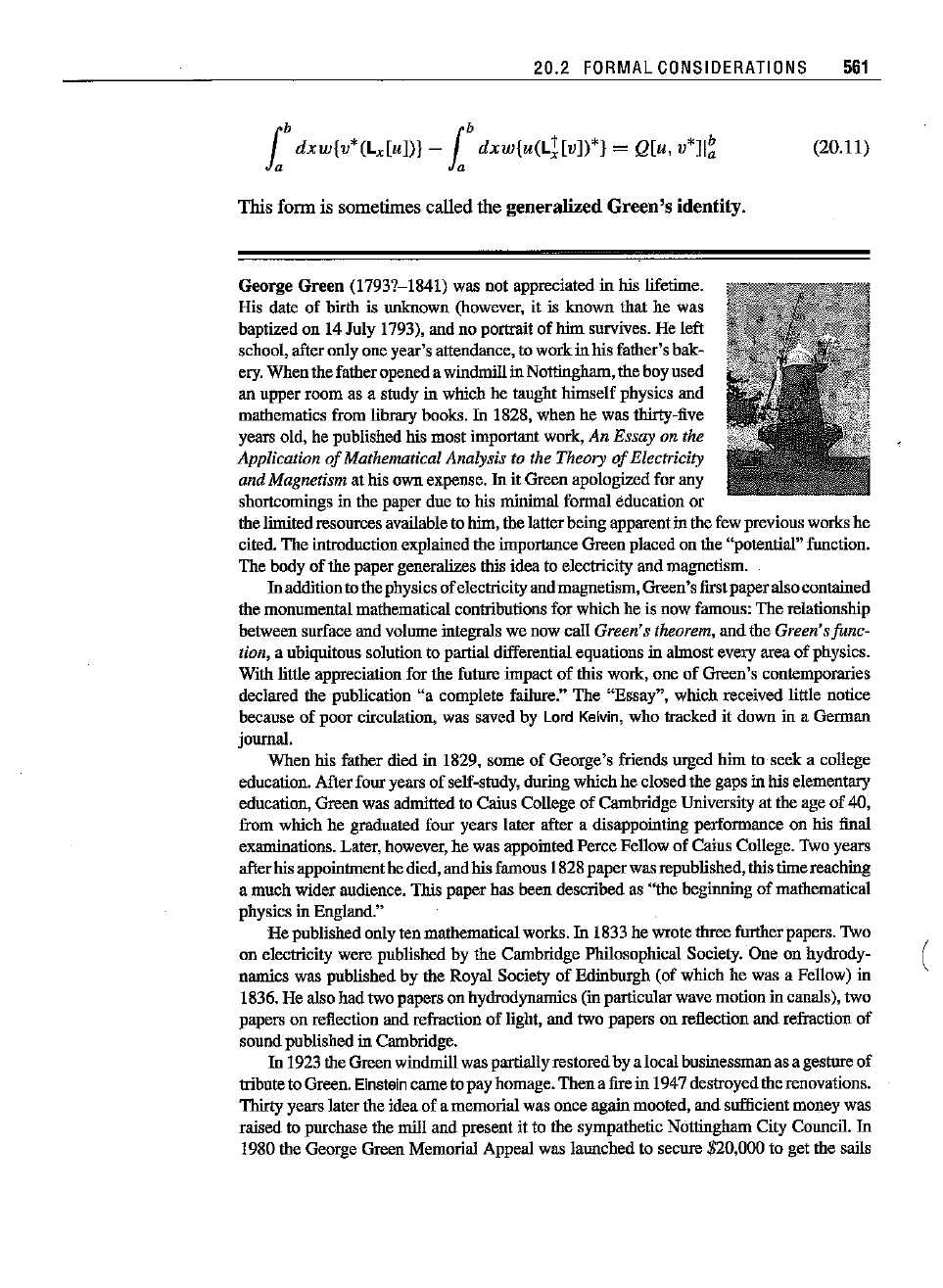
20.2
FORMAL
CONSIOERATIONS
561
l
b
dxw{v*(Lx[u])}
-l
b
dxw{u(L~[V])*}
= Q[u,
v*]I~
(20.11)
This form is sometimes called the generalized
Green's
identity.
George
Green
(17937-1841) was not appreciated in his lifetime.
His date
of
birth is unknown (however, it is
known
that he was
baptized on 14 July 1793), and no portrait
of
him survives. He left
school,afteronlyoneyear'sattendance,toworkin his father'sbak-
ery.
When
the
fatheropeneda windmillinNottingham,the boy
used
an
upper
room
as a study in which he taught
himself
physics and
mathematics from library books.
In 1828,
when
he was thirty-five
years old, he published his
most
important work, An Essay on the
Application
of
Mathematical Analysis to the Theory
of
Electricity
and Magnetism
at his own expense.
In
it Green apologized for any
shortcomings in the paperdue to his minimal formal educationor
the limitedresources available to him, the latterbeing apparentin the few previous works he
cited. The introduction explained the importance
Green
placed on the "potential" function.
The
body
of
the papergeneralizes this
idea
to electricity and magnetism.
In
additionto the physics
of
electricityand magnetism,Green'sfirst paperalso contained
the monumental mathematical contributions for which he is now famous:
The
relationship
between surface and volume integrals we now call
Green's theorem,
and
the Green'sfunc-
tion, a ubiquitous solution to partial differential equations in almost every area
of
physics.
With little appreciation for the future impact
of
this work, one
of
Green's
contemporaries
declared the publication "a complete failure."
The
"Essay", which received little notice
because
of
poor circulation, was saved by Lord Kelvin,
who
tracked it down in a German
journal.
When
his father died in 1829, some
of
George's friends urged
him
to seek a college
education. Afterfour years
of
self-study, during whichhe closed the gaps in his elementary
education, Greenwas admitted
to Caius College
of
Cambridge University at the age
of
40,
from which he graduated four years later after a disappointing performance on his final
examinations. Later, however, he was appointedPerce Fellow
of
Caius College. Two years
afterhis appointmenthe died, and his famous 1828 paperwas republished, this timereaching
a
much
wider audience. This paperhas been described as
"the
beginning
of
mathematical
physics
in England."
He
published only ten mathematicalworks. In 1833 he wrote three furtherpapers. Two
on electricity were puhlished by the Cambridge Philosophical Society. One on hydrody- (
namics was published by the Royal Society
of
Edinburgh (of which he was a Fellow) in
1836. He also had two papers on hydrodynamics (in particular wave motion in canals), two
papers on reflection and refraction
of
light, and two papers on reflection and refraction
of
soundpublishedin Cambridge.
In 1923 the Greenwindmillwas partiallyrestoredby a localbusinessmanas agesture
of
tribute to Green. Einstein cameto pay homage.
Then
a fire in 1947 destroyedthe renovations.
Thirty years later the idea of a memorial was once again mooted, and sufficient money was
raised
to purchase the mill and present it to the sympathetic Nottingham City Council. In
1980 the George Green Memorial Appeal was launcbed to secure $20,000 to get the sails
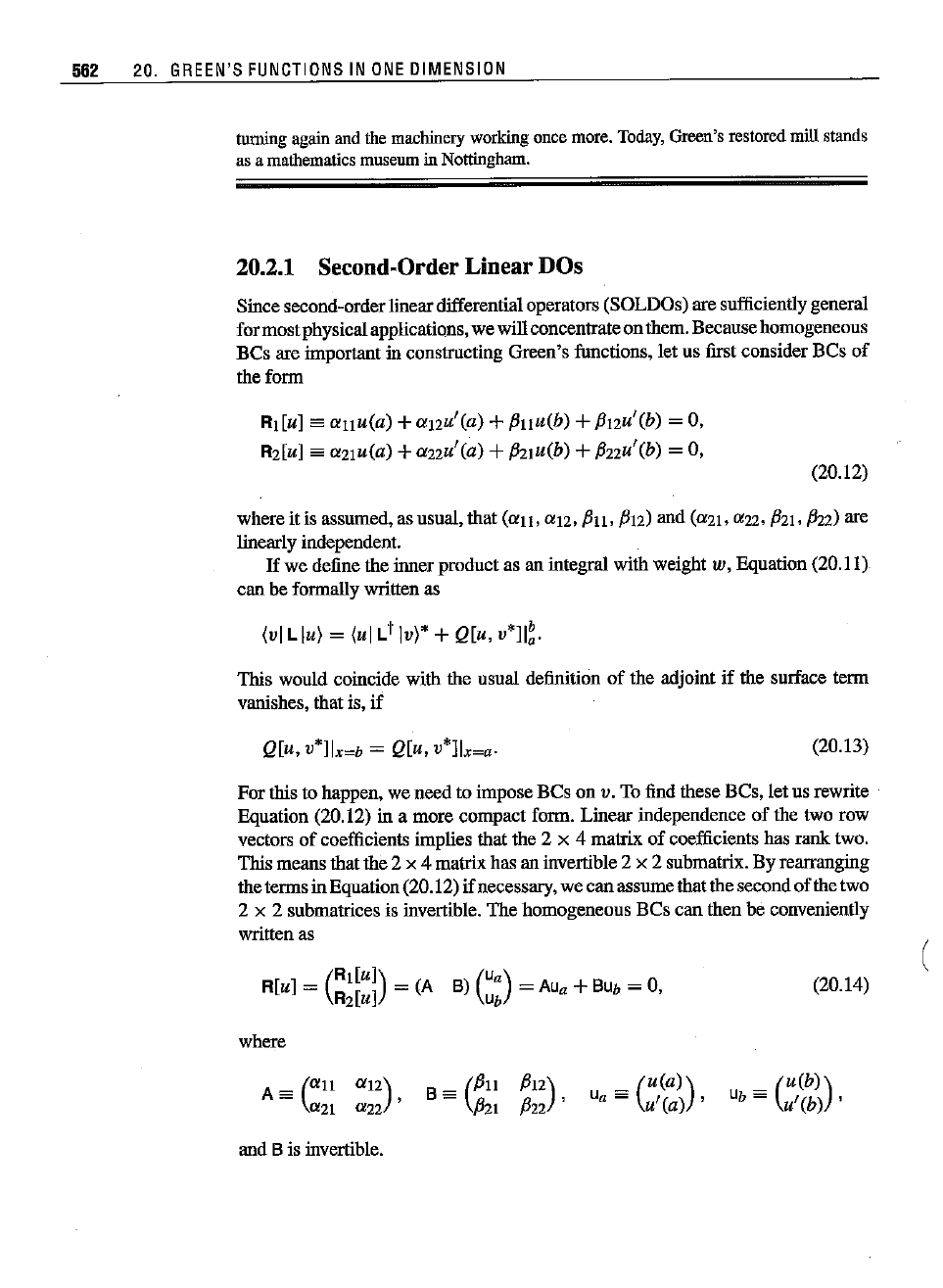
562 20.
GREEN'S
FUNCTIONS
IN
ONE
OIMENSION
turning
again
and
the
machinery
working
once
more.
Today,
Green's
restored
mill
stands
asa
mathematics
museum
in
Nottingham.
20.2.1 Second-OrderLinear DOs
Since second-orderlineardifferentialoperators (SOLDOs) are sufficientlygeneral
for mostphysicalapplications,we will concentrateonthem. Becausehomogeneous
BCs are important in constructing Green's functions, let us first consider BCs of
the form
Rl [u]
'"
"l1u(a)
+"12U'(a) +fJl1u(b) +
fJ12u'
(b) = 0,
R2[ul sa "21u(a) +"22U'(a) +f!21u(b) +
fJ22u'
(b) = 0,
(20.12)
where it is assumed, as usual, that
("11,
"12,
fJl1,
fJ12)
and ("21, "22,
fJ21,
fJ22)
are
linearly independent.
If
we define the inner product as an integral with weight w, Equation (20.11)
can
be formally written as
(vi L lu) = (ul Lt Iv)* +
Q[u,
v*]I~.
This would coincide with the usual definition
of
the adjoint if the surface term
vanishes,
that
is,
if
For this to happen, we need to impose
BCs
on v. To find these BCs, let us rewrite
Equation (20.12) in a more compact form. Linear independence of the two row
vectors
of
coefficients implies that the 2 x 4 matrix of coefficients has rank two.
This means that the 2 x 4 matrix has an invertible 2 x 2 submatrix. By rearranging
the terms in Equation(20.12) if necessary, we
can
assume that the secondof the two
2 x 2 subrnatrices is invertible. The homogeneous BCs
can
then be conveniently
written as
Q[u,
v*llx=b =
Q[u,
v*]lx=a.
R
[u]
=
(Rl[U
1
)
= (A B)
(U
a
)
A +B 0
R2[U] Ub = U
a
Ub = ,
where
(20.13)
(20.14)
(
and Bis invertible.
B
'"
(fJl1 fJ12),
fJ21
fJ22
(
u(a))
u
a
sa u'(a) ,
(
u(b))
Ub'"
u'(b)
,
